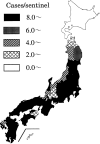Surveillance of viral gastroenteritis in Japan: pediatric cases and outbreak incidents
- PMID: 10804136
- PMCID: PMC7109874
- DOI: 10.1086/315593
Surveillance of viral gastroenteritis in Japan: pediatric cases and outbreak incidents
Abstract
Surveillance results from pediatric cases and outbreaks of viral gastroenteritis in Japan are presented. In winter, both small round structured virus (SRSV, or Norwalk-like viruses) and rotavirus were detected from infants with gastroenteritis; however, in recent years, the prevailing time of SRSV infection has preceded that of rotavirus infection. Most nonbacterial gastroenteritis outbreaks were related to SRSV infection, and >60% of the outbreaks were caused by contaminated food. In small-sized outbreaks, raw oysters were the primary source of transmission. In large-sized outbreaks, school lunches and catered meals that were served at schools, banquet halls, and hospitals were most often implicated in the transmission of foodborne gastroenteritis.
Figures








Similar articles
-
Detection of small round structured viruses in stool specimens from outbreaks of gastroenteritis by electron microscopy and reverse transcription-polymerase chain reaction.Acta Virol. 2000 Feb;44(1):53-5. Acta Virol. 2000. PMID: 10989693
-
Members of the family caliciviridae (Norwalk virus and Sapporo virus) are the most prevalent cause of gastroenteritis outbreaks among infants in Japan.J Infect Dis. 2000 Jun;181(6):2029-32. doi: 10.1086/315500. Epub 2000 Jun 5. J Infect Dis. 2000. PMID: 10837186
-
Two successive outbreaks of SRSV-associated gastroenteritis in South Africa.J Med Virol. 1993 Sep;41(1):18-23. doi: 10.1002/jmv.1890410105. J Med Virol. 1993. PMID: 8228932
-
[The relationship between epidemic gastroenteritis caused by Norwalk viruses (NVs) and acute gastroenteritis in children--based on the history of NVs in Japan].Nihon Rinsho. 2002 Jun;60(6):1208-13. Nihon Rinsho. 2002. PMID: 12078096 Review. Japanese.
-
[Characteristic of Norwalk gastroenteritis and its prevention].Nihon Rinsho. 2002 Jun;60(6):1202-7. Nihon Rinsho. 2002. PMID: 12078095 Review. Japanese.
Cited by
-
Evaluation and comparison of two commercial enzyme-linked immunosorbent assay kits for detection of antigenically diverse human noroviruses in stool samples.J Clin Microbiol. 2004 Jun;42(6):2587-95. doi: 10.1128/JCM.42.6.2587-2595.2004. J Clin Microbiol. 2004. PMID: 15184438 Free PMC article.
-
Norovirus gastroenteritis.Curr Infect Dis Rep. 2007 Mar;9(2):102-9. doi: 10.1007/s11908-007-0004-5. Curr Infect Dis Rep. 2007. PMID: 17324346
-
Atypical norovirus epidemic in Hong Kong during summer of 2006 caused by a new genogroup II/4 variant.J Clin Microbiol. 2007 Jul;45(7):2205-11. doi: 10.1128/JCM.02489-06. Epub 2007 May 2. J Clin Microbiol. 2007. PMID: 17475764 Free PMC article.
-
Risk factors for norovirus, Sapporo-like virus, and group A rotavirus gastroenteritis.Emerg Infect Dis. 2003 Dec;9(12):1563-70. doi: 10.3201/eid0912.020076. Emerg Infect Dis. 2003. PMID: 14720397 Free PMC article.
-
Loop-mediated isothermal amplification (LAMP): a rapid, accurate, and cost-effective diagnostic method for infectious diseases.J Infect Chemother. 2009 Apr;15(2):62-9. doi: 10.1007/s10156-009-0669-9. Epub 2009 Apr 25. J Infect Chemother. 2009. PMID: 19396514 Free PMC article. Review.
References
-
- National Institute of Infectious Diseases and Infectious Diseases Control Division, Ministry of Health and Welfare. Viral gastroenteritis of children, Japan, 1993–1998. Infect Agents Surveil Report. 1998;19:1–2.
-
- National Institute of Infectious Diseases and Infectious Diseases Control Division, Ministry of Health and Welfare. Outbreaks of viral gastroenteritis, Japan, January–October 1997. Infect Agents Surveil Report. 1998;19:248–9.
-
- National Institute of Infectious Diseases and Infectious Diseases Control Division, Ministry of Health and Welfare. Viral gastroenteritis, Japan, October to December 1995. Infect Agents Surveil Report. 1996;17:21–2.
-
- National Institute of Infectious Diseases and Infectious Diseases Control Division, Ministry of Health and Welfare. The national epidemiological surveillance of infectious diseases in compliance with the enforcement of the new infectious diseases control law. Infect Agents Surveil Report. 1999;20:88–90.
MeSH terms
LinkOut - more resources
Full Text Sources
Other Literature Sources
Medical

